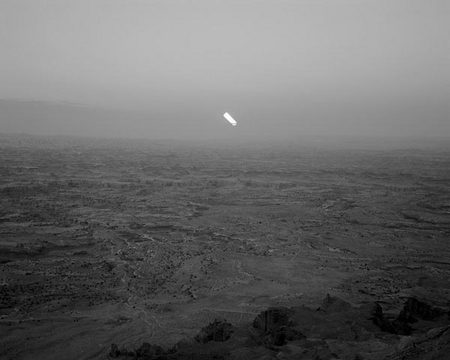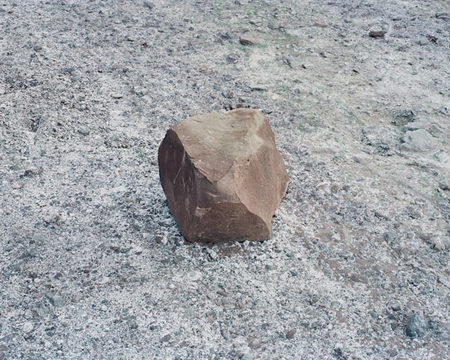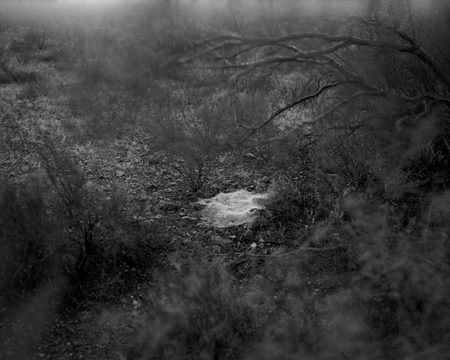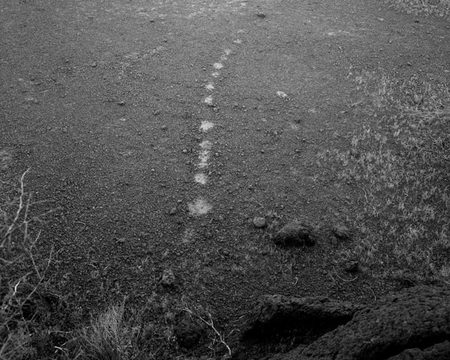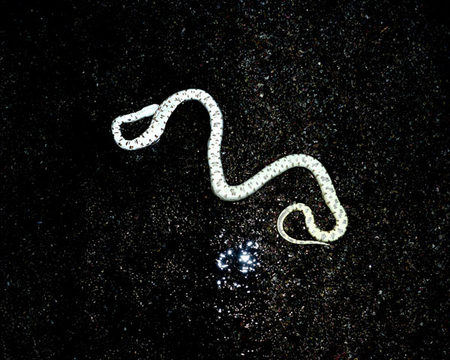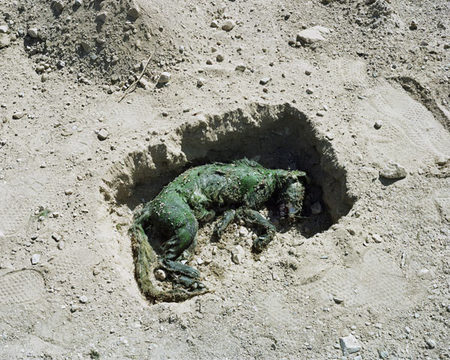A Conversation with Michael Lundgren
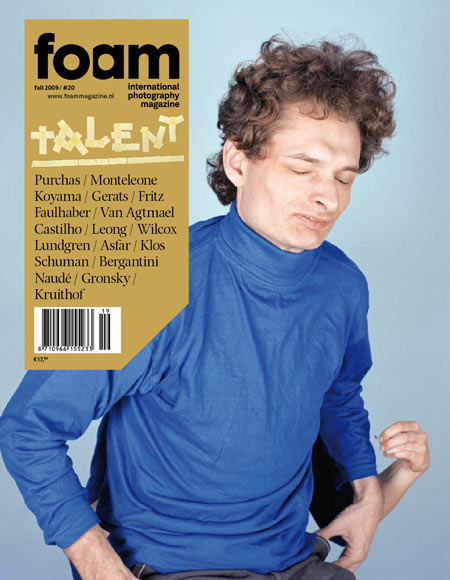
The Fall 2009 edition of FOAM International Photography Magazine is dedicated to showcasing the work of up-and-coming photographers. This year, there are 18 photographers - a very diverse group. FOAM approached me earlier this year to ask whether I was available to conduct interviews with each the photographers, and, of course, I agreed to it. The following conversation with Michael Lundgren is the full version of the abridged one printed in FOAM 20.
Jörg Colberg: I’d like to start off by talking about what might sound like technique, but which, I think, is more than that. When I look at your series Transfigurations, it’s very stark. Many photos are either almost completely black or completely white. Can you tell me a little bit what motivated you to take this approach?
Michael Lundgren: Photography is a duality: a record and a transformation. Jonathan Greene describes this perfectly in American Photography: “The camera cannot lie, neither can it tell the truth. It can only transform.” I have always hoped to make photographs that deal with these two facets of the medium. On the one hand this work was made in a specific environment, the deserts of Arizona, Utah and Mexico; and my hope is that these pictures speak to the experience of being in these places. On the other hand, these pictures relate as much to the history of landscape as they do to the land they traverse. By embracing the transformative capacity of the medium, I hope to follow a thread through the immense variety of experience in the desert, as well as the approaches to landscape photography of my predecessors.
In the desert one is often confronted by extremes of light and dark. These pictures are motivated by the experience of the Sublime: a meeting of my own personal awareness with something much larger. In this, what one knows is often obliterated by the vast mystery of place. This obliteration can happen at high noon, or in the gray black of the desert night. By working at the edges of photography’s sensitivity, I hope to circuitously speak to that experience. I was conversing with an astronomer recently about the origins of solar systems. He described a molecular cloud of dust and gas surrounding the beginnings of a star. The grains of dust are so dense that no light from the Milky Way can enter. With no light, the temperature drops, lowering the pressure in the cloud. Eventually the gravity of the cloud overcomes its internal pressure, collapsing on itself. Only in utter darkness can light be born. From the facts, form arranges content, allowing space for the birth of metaphor.
JC: Even though Matter at first seem more (literally) colourful, its imagery is as stark as that of Transfigurations. Is this starkness, which makes for an intense experience when looking at the photographs, something that has deeper meaning for you?
ML: As this work is very new, I’m hesitant to say too much as my understanding of the work is not complete. Stark is a way to describe it, but perhaps more appropriate is the word reduced. As with Transfigurations, I’m interested in reducing the world to a bare essential, to get closer to the heart of experience. By photographing in non-directional light or with on-camera flash, and printing with a less saturated palette I’m able to reduce the picture to an essential quality, a direct presentation of a symbolic subject amidst a field of mute color. I hope that this work produces an intense experience. On one level these pictures are motivated by a history of violence in the desert, not just our own politically underwritten aggression, but nature’s violence as well. As well, at the heart of this work is the notion of two levels of time: shallow time and deep time. The life of cells and the life of stone.
JC: How do you approach working on a series? Is there an idea, and then you try to fill it with images? Or do you have images, and you then develop the series? And how do you find the photographs for your series?
ML: I’m a student of the Nathan Lyons school of photography. As a graduate student I worked extensively with William Jenkins and Mark Klett, both former students of Nathan. In this tradition, photography is ideographic; photography is its own language. A body of work developed over time deals with the associations of picture to picture rather than the notion of the preconceived photographic masterpiece. By working intuitively (making photographs, digesting those photographs, going out to make more), one allows meaning to develop and be sustained by the pictures themselves, rather than by a pre-formulated idea or simple continuity of subject matter. By keeping the work in the back of my mind, I’m drawn to make certain photographs, yet I never know what I’m going to photograph next.
JC: If one wanted to use simple labels, Transfigurations would probably be classified as “landscape photography,” even though your landscapes look nothing like most other landscapes. I’m curious how you see yourself in the tradition of landscape photography? Is this something that you have thought about?
ML: Yes, very much. Good work must be connected to history. I feel that Transfigurations threads its way through the history of landscape, in terms of photographic vision and meaning. However, as Mark Klett says, “Landscape is ripe for reinvention.”
In response to the idealization of nature as an Eden, landscape shifted dramatically with the work of the New Topographics’ photographers. This shift is more complex than I can describe here, driven by major changes in photographic seeing. In no way do I mean disrespect towards my forbearers, yet both of these movements have something in common: “Look at how great nature is. Look what we’ve done to it. It is better off without us.” But since then, we’ve been inundated by work that describes human devastation, but has done nothing to engage with the ‘optical democracy’ of New Topographics. There is little room for personal experience or for a spiritually-motivated response to place. This comes from an imposed limitation that acknowledges only one half of the photographic duality: the record. I’m interested in what lies beneath the surface, what exists because we are perceptive beings, susceptible to direct impressions and in need of mythology.
JC: Care to elaborate on this a bit? I’m interested in your idea of mythology especially.
ML: I’m just beginning to understand this myself. Western culture is a bit short on myth. And perhaps for us humans, the choice has become between mythology and fantasy. Much of my experience with mythology comes from the writings of Joseph Campbell, David James Duncan and Carlos Castaneda. What interests me is the idea that mythology is real. In one sense mythology gathers small untruths that when taken as a whole form a story of humanity’s real experience and striving. Through the symbolic interpretation of mythological archetypes: the desert, its phenomena, its blinding light and enveloping darkness, what cannot be expressed in words can be made clear in metaphors: the stories and poetic truths I feel to be both fundamental and transcendent.
JC: … and then, of course, I’m curious about your photographic influences? And are there other, non-photographic artists, who have shaped your own development as an artist?
ML: The list is quite long so I’ll try to be succinct. I think the strongest photographic influences on me include: Emmet Gowin, Timothy O’Sullivan, Mark Klett, Minor White, Robert Adams, Christian Widmer and Aaron Rothman. I have also been greatly influenced by the artists Caspar David Friedrich, Robert Smithson, Robert Motherwell and Richard Long. Another strong influence in my work are the teachings of G.I. Gurdjieff, as well as the writings of the American Transcendentalists.
JC: A lot of photographers are trying to push the boundaries of what photography actually is, and I do sense a bit of that in your work. Is this something you are interested in?
ML: Yes and No. I’m simply trying to understand photography, to make work that deals with photographic formalism, an often-misunderstood idea. Formalism is not just about the way content is arranged; it is a means of relating medium specificity to a larger impulse. Dealing with the medium in a simple way is enough for me. The word radical comes from the Latin ‘radix’, meaning root. Much contemporary work is disconnected to the trace of history, disjointed from the essential paradox of photography. Instead it becomes based on technological possibilities and the spectacle of the subject, not on a primary understanding of the medium. Photography’s future is in peril. New technology has made the medium more democratic, but a nuanced understanding of the inherent dialectic in photography is at the risk of being lost or disregarded. In the end, I hope that my work is in conversation with a lineage and that my part in that conversation moves picture-making forward.
JC: Someone like Thomas Ruff would probably happily argue that photography’s future is only in peril if we stick with what photography used to be, ignoring the potential that new technologies have added to it. Might it not be time to re-think old ideas of what photography is, given that image making now encompasses ways that people would have never imagined in the past? Or asked in a different way, above you said that photography was a transformation: Haven’t recent photographic developments made this fact clearer than it ever was?
ML: First off, I am not a luddite. Much of my work is heavily altered in the computer as well as the darkroom. In a sense, directorial photography has been steadily supplanting what Paul Graham calls analytical photography, which is what I do. And much directorial photography and digital compositing (directorial’s newest agency) is so seamlessly crafted in intent and message that it is often indistinguishable from the world of fashion and advertising. I don’t believe that technology alone will lead to an expansion of what photography is. Making five different versions of oneself in a tree house is nothing new. Pictorialists were creating directorial narratives 100 years ago and Muybridge was seamlessly printing rocks and skies into his albumen prints. Instead, of interest to me is how digital will change photographic formalism. What does the world look like photographed digitally? Does the transformation exist simply because one creates a composite, or is it something more integral to the way digital sees the world, perhaps as hyper-reality, a state where it is impossible to distinguish between reality and fantasy?
The “Transfigurations” book can be bought here.
 By
By 